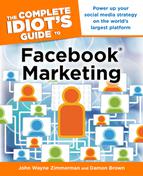When Fan Pages Don’t Cut It
Remember how people get onto your Fan page? They simply click a Like icon and, voilà, they’re suddenly on your virtual mailing list.
Unfortunately, Fan pages don’t offer much insight into who these people are or whether or not they like your product—they could have hit your Like link by mistake or because a friend did! Fan pages are definitely the way to go if you’re interested purely in numbers, but sometimes you want to create a community with a little more finesse. This is when a Group page comes in handy.
| DEFINITION |
A Group page is a Facebook area where people interested in a particular topic can mingle, exchange messages, and engage in other community-oriented actions. Groups can be open to the public, by invite only, or completely hidden from nonmembers.
Joining a Facebook Group isn’t as simple as clicking a Like button. It can be as sophisticated as getting an invite to a private club or as simple as meeting certain group qualifications. And the group organizer has the right to refuse people membership or even kick people out of the club.
On a Group page, the admin—more than likely you—determines the group’s dynamics. Facebook lets users create the following three types of Facebook Groups:
• Hidden
• Closed
• Open
Your visitor’s experience changes dramatically depending on the type of group. The following sections describe each type of group in detail.
Hidden Groups
When a group is hidden, it doesn’t appear on any search list. You actually need to know about it and directly type in the group name in order to find it.
On Facebook, go to the search bar at the top of the screen and begin typing in a word like, say, “McD.” Facebook autofills the search box and suggests several, if not dozens of, pages you may be looking for (in this example, the majority of suggestions would be McDonald’s pages; see Figure 8.1). A search like this is an easy way to find a group of your interest.
| FRIENDLY ADVICE |
Hidden groups tend to have fewer members compared to a Fan page or even an invite-only group. However, the low number of members means that the people who are in it feel special. The more special they feel, the more likely they’ll be to express their loyalty to your brand—monetarily or otherwise.
A hidden group can give the air of exclusivity and mystery, two feelings that could work well with the right brand. For example, a hip college radio station may have a significant following in the real world, but only the coolest kids know about the Facebook group hiding in plain sight. You can imagine that the conversations, camaraderie, and even competition among members would be higher on such a page than it would be on a Fan page.
Closed Groups
You don’t need to hide your group to keep it exclusive. Instead, you can make the group invite-only by choosing the Closed privacy setting. The name of a closed group shows up when you perform a search for it, but only members are able to see the contents.
You can manage closed groups in two ways: you can give clearance on every new member, or you can empower members themselves to bring in new people. Both approaches have their pros and cons.
| FEEDBACK |
You can change the type of group at any time—from closed to open, for example. However, we caution against making too many changes after your Group page is up and running because you always want to present a consistent identity of your business.
If you retain the power over giving clearance on every member, you can handpick who you’d like to be in the club. Unfortunately, handpicking takes a lot of time and effort. If your page takes off the way you’re hoping it does, you would have to dedicate serious resources to deciding on new members, an amount of work that could get even more concerning as the group gets more popular and more people ask to join.
Letting members vouch for new members builds up trust in the community and takes the pressure off of you to manage initial membership. The challenge is that, by giving up some power, the members may end up co-signing people who are toxic to your group. In other words, you have to monitor new members anyway.
Open Groups
The simplest approach is to make your group open to the public. Sounds just like a Fan page, right? They’re very similar.
A key difference between the open-by-default Fan page and the open Group page is that the Group page enables you to contact all members directly and simultaneously. We get into group communications later in the chapter.

